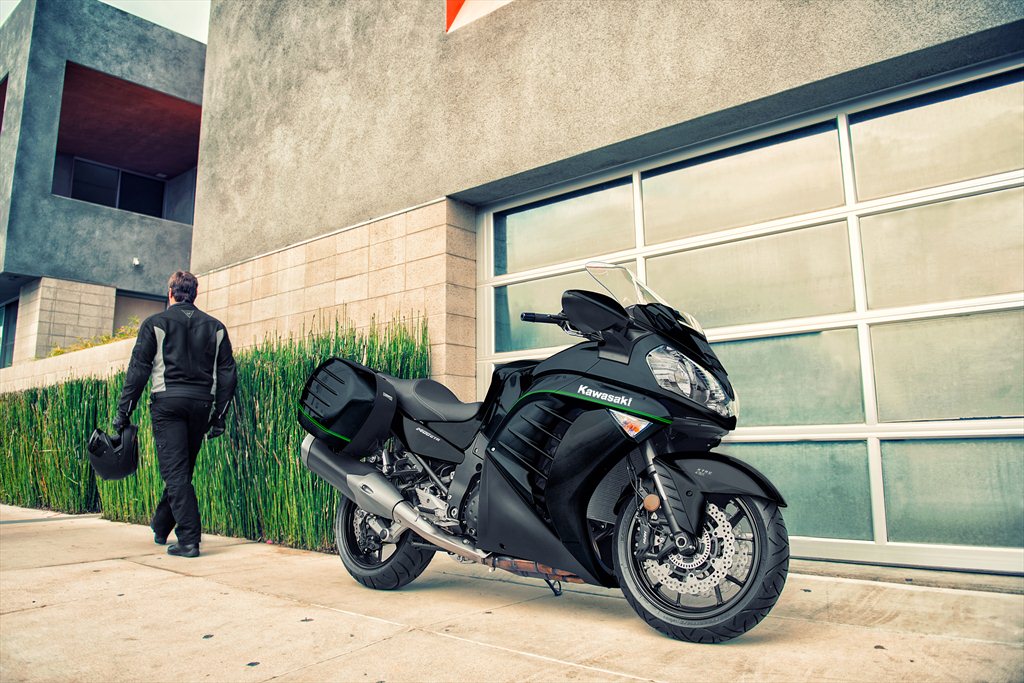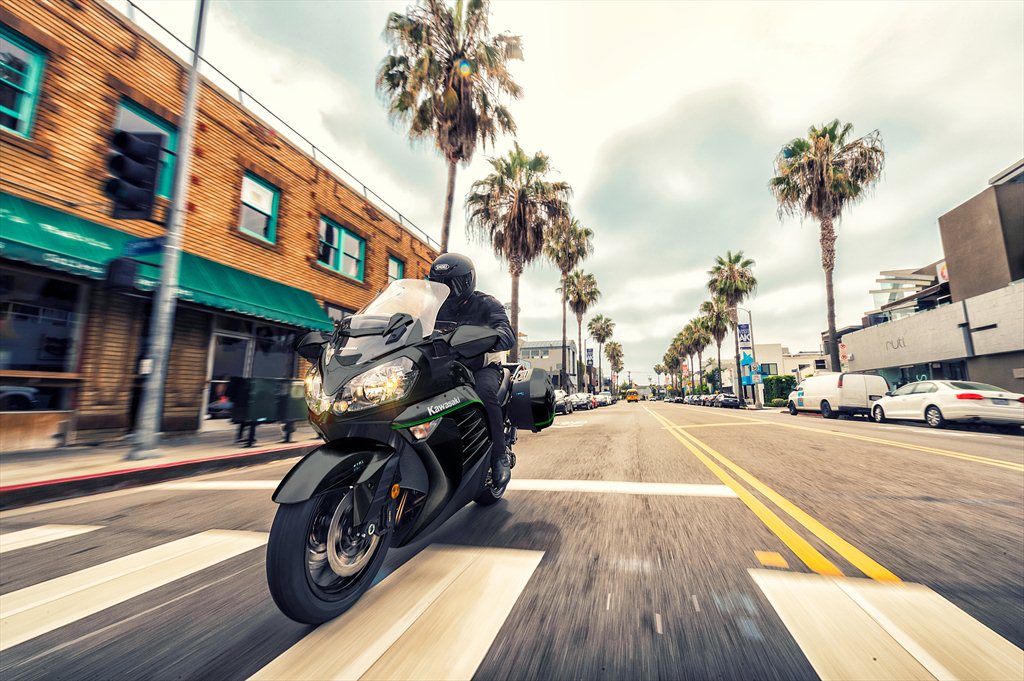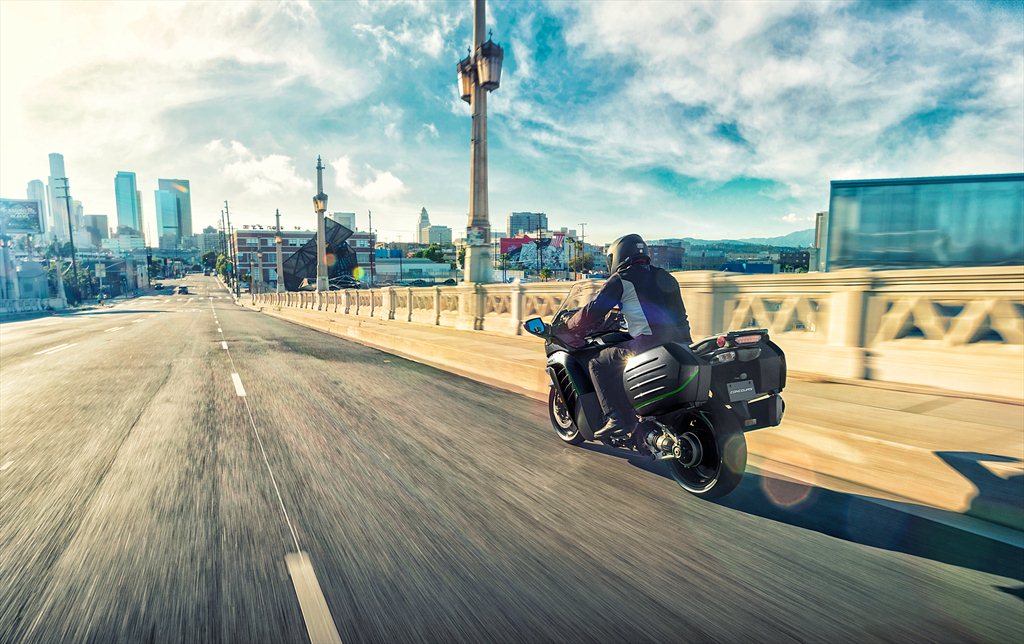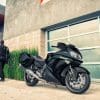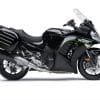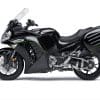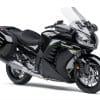The 2021 Kawasaki Concours 14 ABS: Designed For Long-Distance Sports Touring
Contents
The 2021 Kawasaki Concours 14 ABS is the latest model of the Japanese manufacturer’s entry into the long-range sports touring category. Utilizing a 1,352 cc DOHC liquid cooled inline-four, the biggest four cylinder in the entire Kawasaki lineup, 158 HP and 111 lbs-ft torque is available. This is easily enough to accelerate and maintain speed on the variety of highways, interstates, and freeways across North America.
The Concours 14 continues using the 2020 model’s equipment, with dual throttle valves (standard and ram air), Kawasaki Traction Control, Kawasaki Advanced Co-Active Braking (unified braking), KIPASS (proximity key sensing), electronically adjustable windscreen, and a full tire pressure monitoring system. As well, the Concours 14 comes with ABS, and built in hard case saddlebags as standard.
The 2021 Kawasaki Concours 14 ABS starts at $15,799 USD / $18,799 CAD.
On this page: we’ve curated specs, features, news, photos/videos, etc. so you can read up on the new 2021 Kawasaki Concours 14 ABS in one place.
Model Overview
General Info
- Price: $15,799 USD / $18,799 CAD
- Key Features:
-
- Dual-zone ABS
- Full monocoque frame for excellent stability and durability
- Tire Pressure Monitoring System (TPMS)
Main Specs
- Engine Type: 1,352cc 4-stroke, 4-cylinder, DOHC, 4-valve, liquid-cooled
- Horsepower: 158 HP
- Torque: 111 lb-ft
- Wet Weight: 672 lbs (305 kg) (with saddlebags empty)
- Seat Height: 32.1 inches (815 mm)
Competitors
2021 Kawasaki Concours 14 ABS Specifications
ENGINE |
||
| Engine | 1,352cc 4-stroke, 4-cylinder, DOHC, 4-valve, liquid-cooled | |
| Power | 158 HP | |
| Bore x Stroke | 84.0 x 61.0mm | |
| Compression Ratio |
10.7:1
|
|
| Fuel System | DFI® with 40mm throttle bodies (4) | |
| Starter | Electric | |
| Lubrication | ||
DRIVETRAIN |
||
| Clutch | ||
| Transmission | 6-speed | |
| Final Drive | Tetra-Lever shaft drive | |
CHASSIS |
||
| Suspension Front | 43mm inverted, telescopic fork with adjustable rebound damping and spring preload/4.4 in | |
| Suspension Rear | Tetra-Lever with stepless rebound damping adjustment and remote spring preload adjuster/5.4 in | |
| Brakes Front | Dual floating 310mm petal-style discs with four-piston calipers, ABS | |
| Brakes Rear |
Single 270mm petal-style disc, single-piston caliper, ABS
|
|
| Tires Front | 120/70 ZR-17 | |
| Tires Rear | 190/50 ZR-17 | |
| Fuel Tank Capacity | 5.8 gal | |
| Color |
Metallic Spark Black
|
|
ELECTRICAL |
||
| Ignition | Digital CDI with 3 Coupler Options | |
| Spark Plugs | ||
| Headlight | LED | |
| Tail Light | LED | |
DIMENSIONS |
||
| Overall Length | 87.8 in | |
| Overall Width | 31.1/39.4 wo/w saddlebags | |
| Overall Height | 52.9 in/57.7 in (windshield down/up) | |
| Wheelbase | 59.8 in | |
| Ground Clearance | 4.9 in | |
| Seat Height | 32.1 in | |
| Curb Weight | 690.2 lb (672.5 w/o saddlebags) | |
WARRANTY |
||
| Warranty | 36 Month Limited Warranty | |
| Kawasaki Protection Plus | 12, 24, or 36 months | |
2021 Kawasaki Concours 14 ABS Features
Dual Throttle Valves
On models with dual throttle valves, there are two throttle valves per cylinder: in addition to the main valves, which are physically linked to the throttle grip and controlled by the rider, a second set of valves, opened and closed by the ECU, precisely regulates intake airflow to ensure a natural, linear response. With the air passing through the throttle bodies becoming smoother, combustion efficiency is improved and power is increased.
Economical Riding Indicator
While effective vehicle speed and engine speed may vary by model, paying attention to conditions that cause the “ECO” mark to appear can help riders improve their fuel efficiency – a handy way to increase cruising range. Further, keeping fuel consumption low also helps minimize negative impact on the environment.
Fuel Economy Assistance Mode
Maximizing the effectiveness of the Fuel Economy Assistance Mode requires a gentle use of the throttle. Nevertheless, especially when used in conjunction with the Economical Riding Indicator, this mode can contribute to significant savings in fuel costs over long distances.
KTRC (Kawasaki Traction Control) (1-mode)
When accelerating on a slippery surface, the rear wheel may spin (i.e. when the rear wheel turns faster than the front wheel). KTRC was designed to minimize wheel spin that could otherwise cause the loss of control of the bike. Like ABS helps prevent wheels from locking up when braking, Kawasaki’s original traction control system minimizes rear tire slippage. Knowing that the system will intervene to prevent sudden wheel spin when, for example, the pavement comes to an abrupt end when touring, is a great source of reassurance for riders.
KTRC uses wheel speed sensors to monitor front and rear wheel speed. When it detects wheel spin, engine power is reduced to allow rear wheel grip to be regained. KTRC also helps the rear wheel regain traction in situations where grip is lost temporarily, like when riding over a wet manhole cover.
KTRC uses 3-way control, governing ignition timing, fuel volume and (via the sub-throttle valves) intake air volume. This 3-way control is what enables the system to be so smooth, resulting in a very natural feeling.
K-ACT (Kawasaki Advanced Coactive-braking Technology) ABS
Complementing its standard ABS function, K-ACT ABS links the front and rear brakes. It monitors the brake force the rider is exerting at both the front and rear, and takes into consideration vehicle speed to ensure highly effective braking while maintaining chassis stability.
For example, let’s say the rider pulls on the front brake lever. To keep the bike from pitching forward, the ABS ECU actuates the rear brake (via fluid pumps) to ensure that front-rear balance is maintained. Should the rider push the rear brake pedal, the system actuates the front brake as well to distribute the load more evenly so that the rear wheel does not lock up. Based on the vehicle speed, K-ACT decides the optimum hydraulic pressure to send to each caliper, ensuring that even with a heavy motorcycle, stable braking performance is possible.
Accordion Title
When the key fob is close to the bike, the signal it sends out is picked up and recognized by the KIPASS unit in the bike. Like immobilizer keys, each key fob has a unique signal, making this system also useful as a theft deterrent. The key fob can be recognized when in a jacket pocket, so there is no need for the rider to remove the key to operate the bike’s main switch.
*This system uses the encryption algorithm “MISTY” developed by MITSUBISHI ELECTRIC CORPORATION.
Monocoque Frame
The aluminum monocoque frame was originally developed by Kawasaki in the 1980s for their World Grand Prix works racer. In an era where steel pipe frames were the norm, the aluminum monocoque frame that debuted on the KR500 took the world by surprise. First featured on a mass-production model on the 2000 Ninja® ZX™-12R, this original Kawasaki technology has evolved and can be found on some of our large-displacement flagship models.
Tire Pressure Monitoring System (TPMS)
Tire air pressure varies greatly as the tires warm up, but the Tire Pressure Monitoring System takes this into consideration and recalculates the pressure for 20°C (68°F) to avoid confusion and false warnings.
When tire air pressure is excessively low, a tire mark appears on the display, warning the rider. This can contribute to rider peace of mind on long tours.
2021 Kawasaki Concours 14 ABS Photos
2021 Kawasaki Concours 14 ABS Videos
None from official media channels
Links
Kawasaki Official Websites



